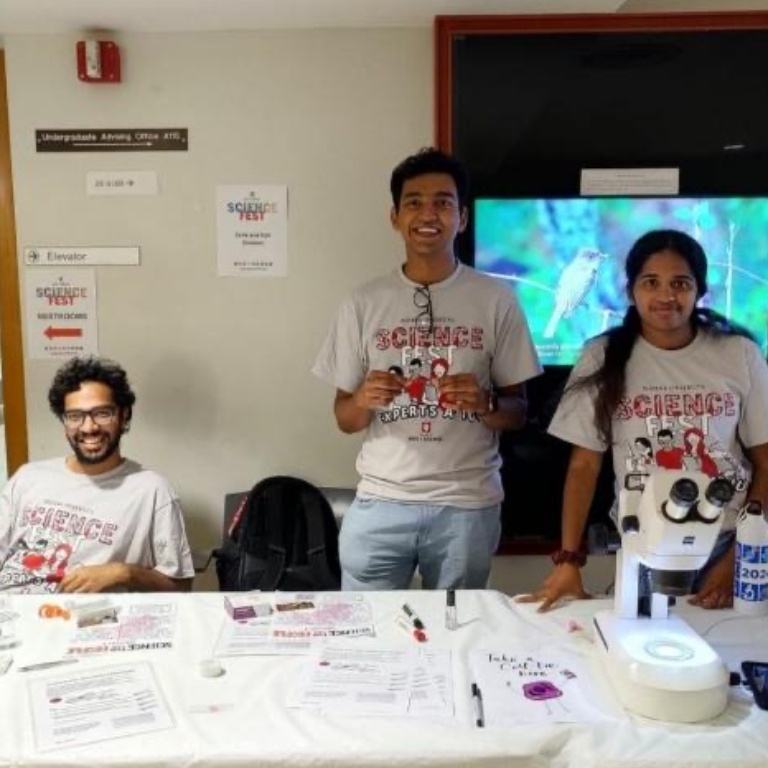Graduate students in Indiana University Bloomington’s Department of Biology are extending their impact beyond the lab and into the community.
Josy Joseph, Anjaly Prasannajith and Siddhartha Yaddanapudi are helping connect IU research with the public through hands-on biology outreach. With guidance from Jean Lennon, director of biology outreach, and support from the outreach team, the students are delivering science experiences that engage learners of all ages.
Prasannajith, a Ph.D. student in the Walczak lab and part of the Cell, Molecular and Cancer Biology program, wanted to get involved with the community. She reached out to Lennon, and the two began discussing ways to introduce students to cell biology. They talked about the idea of showing kids dividing cells and then Prasannajith invited Yaddanapudi to join the effort. Together, they developed the concept into an outreach activity.
Joseph is a first-year Ph.D. student in the Genome, Cell and Developmental Biology program and conducts research in the Zelhof lab studying horn development in beetles. He joined the initiative with the hope of inspiring younger students to learn more about science.
Yaddanapudi studies plant cell growth and cytoskeleton organization in the Genome, Cell and Developmental Biology program and is a member of the Shaw lab. He had participated in IU’s Science Fest in previous years and was eager to take on more. “It was very nice interacting with people of all ages and seeing them interested in science from a non-scientist perspective,” he said. “That is super refreshing.”
The group collaborated to create a microscope-based activity to demonstrate cell structures and division. The activity is flexible enough to be adapted for different age groups, from young children to adults.
“The biology outreach team helps fine-tune the activities to ensure they are inclusive and accessible to all ages,” Yaddanapudi said.
Prasannajith emphasized the importance of being responsive to each group’s interests. “So, for the younger students, we would be so excited to show them the cells, but sometimes they are more excited in turning the microscopes around or just turning the knobs and looking through the microscopes, or putting tissue paper under the microscopes and seeing what that looks like.”
She added that the ultimate goal goes beyond simply explaining biology. “For me, the reward is more than learning what a cell is made of, or what the process of cell division is,” Prasannajith said. “We hope students become curious to look at the things around them and get excited about science.”
Yaddanapudi described the contrast between research and outreach. “Much of grad school is doing experiments that kind of work or don't work super well, or even if they work, they're incremental,” he said. “And there is great joy in finding stuff that is different and novel, and it's very rewarding when that happens. But that doesn't happen as often as one would like it to.
“Outreach is often very immediately rewarding,” Yaddanapudi said. “It makes you feel good to talk to people who are so interested in science. So, it's a nice change of pace. It's super intensive. Every time we have outreach, even if it's for an hour or a couple of hours, I come away just exhausted, but it's so worth it.”
The students say the experience has been as beneficial for them as it is for their audiences.
“As researchers, we should be able to communicate our science to the people around who are the beneficiaries of whatever we are doing,” Prasannajith said. “With this activity with the kids, we are also training ourselves how to interact, how to share science with kids, and how to make them understand what we are doing and the importance of what we are doing. So, it's also helpful for us as graduate students.”
Joseph agreed, adding that outreach provides a meaningful way to give back. “We have a commitment to the community and to society,” he said. “Even though it’s a small experiment with the things that we are doing, I believe it’s going to make a difference.”

 The College of Arts
The College of Arts